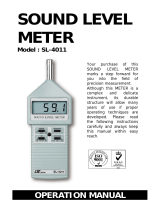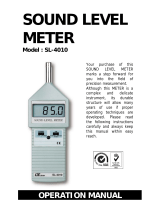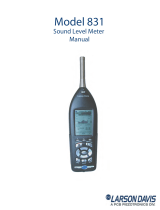Page is loading ...

This addendum presents information for measuring the 3M
TM
Sound Detector SD-200 sound level meter to the IEC61672-1.
The SD-200 computes time-weighted averages over the run-time and is an integrating averaging sound level meter.
Measuring to IEC 61672-1: Look –up table ................................................................................................................................. ii
Level of Linearity with A-weighting measurements (sections: 5.5.11 9.2.7e) ............................................................................. 1
Level of Linearity with C-weighting measurements (sections: 5.5.11 9.2.7e) ............................................................................. 1
Electrical signal input (sections: 5.1.15, 9.3)................................................................................................................................. 1
Maximum input level (sections: 5.1.16, 9.3i) ................................................................................................................................ 1
Linear opearting range (sections: 5.5.10, 9.3f) ............................................................................................................................. 1
Self generated noise levels (sections: 5.6.1 5.6.2 5.6.3, 9.3) ....................................................................................................... 1
Effects of background noise (sections: 5.6.4, 5.6.5, 9.2.5d) ........................................................................................................ 1
Frequency weighting (sections: 5.1.10, 5.4.12) ........................................................................................................................... 2
A Weighting Nominal .................................................................................................................................................................. 2
C Weighting Nominal .................................................................................................................................................................. 2
Frequency weighting (sections: 5.1.10, 5.4.12)(continued) ......................................................................................................... 3
A Weighting Electrical ................................................................................................................................................................ 3
C Weighting Electrical ................................................................................................................................................................ 3
Nominal microphne frequency response, diffraction and reflection corrections (section: 5.2.8) ................................................. 4
Pressure to free field corrections (sections: 5.2.8, 9.2.7d) ......................................................................................................... 4
Pressure to random incidence corrections (section 5.2.7) ........................................................................................................... 5
Display and Integration (sections: 5.15.5, 5.15.6, 5.15.7, 9.2.5f) ................................................................................................ 5
Resetting Overload and Under Range (section 9.2.5 k) ............................................................................................................... 5
Minimum/Maximum integration time (sections: 5.17.1, 5.17.2) ................................................................................................... 5
Reference direction (section 9.2.5a) ............................................................................................................................................. 5
Cable and radio frequency emission (sections: 5.18.1, 5.18.2, 9.3n) ......................................................................................... 5
Battery voltage range and power supply (sections: 5.20.2, 5.20.3, 9.3j) ..................................................................................... 5
Electrostatic discharges (section 6.5.2, 9.2.7 b) ........................................................................................................................... 5
AC power and radio frequency (sections: 6.6.1, 6.6.3, 6.6.4, 9.2.7c, 9.3o) ................................................................................. 5
Directional windscreen corrections (sections: 7.2, 9.2.2b, 9.3d) ................................................................................................. 6
Sound level meter type (section: 9.2.1 a) .................................................................................................................................... 6
Section 9.3 ..................................................................................................................................................................................... 6
General Information .................................................................................................................................................................... 6

Measuring to IEC 61672-1: Look-up Table
A-ii
The following references sections and tables in the user manual in which specific sections of IEC61672-1standard are identified by page number (s). In some instances, the
information is not applicable, as noted below in the Notes section.
* Note: the data within this document will link to the specific section and is designated as pages “A1 – A6). The user manual references are listed as pages 1-11 and do not
hyperlink. Please reference the SD-200 user manual @ http://3m.com/SoundDetector and link to “user manual”)
IEC 61672-1
Section
(User manual
requirements)
Sound Detector SD-200 User Manual and Addendum references
Notes
5.1.4
“SD-200 overview” section (page 1)
5.1.6
“Microphone” section (page 10)
5.1.7
Microphone mounting is not applicable.
5.1.8
Computer software is not used with SD-200.
5.1.10, 5.4.12
“Frequency weighting” sections (page A-2 and A-3)
5.1.12
““Level of Linearity” tables (page A-1)
5.1.13
“References direction” (page A-5)
“Positioning and tripod mount” (page 8)
“Level of Linearity” tables (page A-1)
5.1.14
“Resetting” (page 9)
5.1.15
“Electrical signal input” (A-1)
5.1.16
“Maximum input levels” (A-1)
5.1.17
The SD-200 is a single channel instrument
5.1.18
“Powering on” (page 2)
5.2.1
“Calibrating” (page 9)
“Accessories” (page 12)
5.2.4, 5.2.5, 5.2.7
“Nominal microphone frequency response , windscreen, diffraction and
reflection corrections” (page A-4)
5.2.8
“Pressure to free field corrections” (page A-4)
5.4.12
No optional frequency responses
5.5.9, 5.5.10,
5.5.11
“Display range” (page 11)
“Linear operating range” (page A-1) and
“Level of Linearity” tables (page A-1)
5.6.1, 5.6.2, 5.6.3
“Self generated noise levels” (page A-1)
5.6.4, 5.6.5
“Effects of background noise” (A-1)
5.7.1
“Time Weighting” (page 11)
5.10.1
“Overload” in Screen indicators table (page 6)
5.11.1
“Under Range” in Screen indicators table (page 6)
5.12.1
No peak C levels
5.14
No thresholds used for integrating-averaging
5.15.2, 5.15.3,
5.15.4
“Screen indicators” (page 6)
“Display” (page 11)
5.15.5, 5.15.6,
“Display and Integration” (page A-5)
5.15.7
No digital output
5.16.1
No AC or digital output -
5.17.1, 5.17.2
Not applicable
5.18.1, 5.18.2
“Cable and radio frequency emissions” (page A-5)
5.19.2
The SD-200 is a single channel instrument
5.20.2, 5.20.3
“Battery voltage range and power supply” (page A-5), page 10
5.20.4, 5.20.5
No external power supply
6.1.2
Environmental effects not applicable
6.2.2
“Environmental effects” (page 11)
6.5.2
“Electrostatic discharges” (page A-5)
6.6.1, 6.6.3, 6.6.4
“AC power and radio frequency” (page A-5)
6.6.9
Not applicable
7.1
No microphone extension device or cable
7.2
“Directional Windscreen corrections” (page A-5)
7.3
No optional installed accessories
7.4
No filters used with the SD-200
7.5
No auxiliary devices with the SD-200
9.2.1 General
a
“Standards” section (page 10)
b
“SD-200 Overview (page 1)
“Operating” (page 3)
c
“Microphone” (page 10)
d
No microphone extension device or cable used with the SD-200.
e
The SD-200 is a single channel instrument

Measuring to IEC 61672-1: Look-up Table
A-iii
IEC 61672-1
Section
Sound Detector SD-200 User Manual and Addendum references
Notes
9.2.2 Design features
a
“Screen indicators” section (page 6)
b
“Directional windscreen corrections” (page A-6)
c
“Frequency weighting” (page A2 – A3))
d
“Measurements/frequency weighting and time response” (page 11)
e
The SD-200 is a single range SLM, not applicable.
f
The SD-200 is a single range SLM, not applicable.
g
“Screen indicators” (page 6 and A5)
h
“Level of linearity” (page A-1)
i
“Frequency weighting” (page A-2, A-3)
j
No computer program software used to operate the SD-200
k
Not applicable.
9.2.3 Power supply
a
“Electrical characteristics” (page 10)
b
“Screen Indicators” (page 6)
“Battery voltage” (page A-5)
c
No external power
d
No a.c. electrical power supply
9.2.4 Adjustments to indicated levels
a
“Calibration” (page 12)
b
“Calibration” (page 12)
c
“Calibrating” (page 9)
d
“Corrections” (page A4 – A5)
9.2.5 Operating the sound level meter
a
“Directional windscreen corrections” (page A-6)
b
“Positioning and tripod mount” (page 8)
c
The SD-200 measures sound level using a single range
d
“Effects of background noise” (page A-1)
e
“Powering on” (page 2)
f
“Display and integration” (page A-5)
g
No pre-set for integration time or time of day setting
h
“Minimum/Maximum integration time” (page A-5)
i
No hold function on the SD-200
j
“Resetting” (page 9)
k
“Resetting Overload and Under Range” (page A-5)
l
No threshold settings used on the SD-200
m
No downloading of data capability on the SD-200
n
“Cable and radio frequency emissions” (page A-5)
o
“Self generated noise levels” (A-1)
p
No AC or digital output used with the SD-200.
9.2.6 Accessories
a
No optional installed accessories
b
No microphone extension device or cable
c
No bandpass filters used
d
No auxiliary devices used

Measuring to IEC 61672-1: Look-up Table
A-iv
IEC 61672-1
Section
Sound Detector SD-200 User Manual and Addendum references
Notes
9.2.7 Influence of variations in environmental conditions
a
Not intended for operating in environmentally controlled enclosure.
b
“Electrostatic discharges” (page A-5)
c
“AC Power and radio frequency” (page A-5)
9.3 Instruction manual shall contain the following testing, as appropriate to a sound level meter
a
“Section 9.3 a.” (page A-5)
b
“Section 9.3 b” (page A-5)
c
“Section 9.3 c.” (page A-5)
d
“Pressure to free field corrections” (page A-4)
e
“Level of Linearity” tables (page A-1)
f
“Level linearity” (page A-1)
g
“Electrical signal input” (page A-1)
h
“Self generated noise levels” (page A-1)
i
“Maximum input level” (page A-1)
j
“Battery voltage range and power supply” (page A-5)
k
Not applicable
l
“Environmental effects” (page 11)
m
Not applicable
n
“Cable and radio frequency emission” (page A-5)
o
“AC power and radio frequency” (page A-5)

Level of Linearity with A-weighting measurements (sections: 5.5.11 9.2.7e)
A Weighting Nominal
A-1
Note: Reference level 114 dB with calibration point of 63V
MB
= 114 dB @ 1 kHz
Note: Reference level 114 dB with calibration point of 63V
MB
= 114 dB @ 1 kHz
The microphone is not removable therefore no electrical input is provided. If an electrical input is needed for pattern approval testing, please contact the factory for information.
The maximum input level is 150 dB.
The starting level for measuring level linearity is 114 dB at all frequencies.
Level of self-generated noise in decibels (dB)
Background noise can cause considerable error in measurement when its intensity is close to that of a particular sound source of interest. When it is not possible to eliminate or
reduce the background noise, use the curve shown in Figure 4 to correct for the effect of the background noise on the measurement. For example, if the background noise is 45
dB and the sound of interest measures 51 dB, the difference between measurement and background noise is 6 dB. From Figure 4, for a 6 dB difference, 1.3 dB should be
subtracted from the measurement. The correct measurement is therefore 51 dB- 1.3 dB= 49.7 dB.
Frequency
SPL A Weighting
Linear Operating Range (dB)
LEQ A Weighting
Linear Operating Range (dB)
31.5
85
130
85
130
1000
45
130
45
130
4000
45
130
45
130
8000
45
130
45
130
Frequency
SPL C Weighting
Linear Operating Range (dB)
LEQ C Weighting
Linear Operating Range (dB)
31.5
48
130
48
130
1000
45
130
45
130
4000
46
130
45
130
8000
48
130
48
130
A Weighting
C Weighting
43
41

Frequency weighting (sections: 5.1.10, 5.4.12)
A Weighting Nominal
A-2
Chart: Effects of background noise
The graph below is the nominal A weighting frequency response
The graph below is the nominal C weighting frequency response
-70
-60
-50
-40
-30
-20
-10
0
10
10 100 1000 10000 100000
Relative dB
Frequency Hz
-20
-15
-10
-5
0
5
10 100 1000 10000 100000
Relative dB
Frequency Hz

Frequency weighting (sections: 5.1.10, 5.4.12)(continued)
A Weighting Electrical
A-3
The graph below is the electrical A weighting frequency response
The graph below is the \electrical C weighting frequency response.
-70
-60
-50
-40
-30
-20
-10
0
10
10 100 1000 10000 100000
Relative dB
Frequency Hz
-20
-15
-10
-5
0
5
10 100 1000 10000 100000
Relative dB
Frequency Hz

Nominal microphne frequency response, diffraction and reflection corrections (section: 5.2.8)
C Weighting Electrical
A-4
Note: Add correction to electrical frequency response.
Range 1/3 Octave Frequency Hz
Nominal Microphone Response, Diffraction, Reflection and Windscreen corrections in dB
63
0.1
80
0.0
100
0.1
125
0.1
160
0.0
200
0.0
250
-0.1
315
-0.2
400
-0.3
500
-0.3
630
-0.5
800
-0.4
1000
-0.2
1250
-0.3
1600
-0.2
2000
-0.1
2500
-0.4
3150
-0.7
4000
-0.4
5000
-0.6
6300
-1.6
8000
-1.5
Note: add to pressure response to get 0
o
incidence free-field response. B&K 4226 calibrator may be used to determine the pressure field response.
Frequency in Hz
SD-200 pressure field to free field
corrections in dB
Expanded uncertainty of measurement 95%
confidence in dB
63
0.0
0.32
80
0.0
0.26
100
0.0
0.26
125
0.0
0.19
160
0.0
0.19
200
-0.1
0.13
250
-0.3
0.12
315
-0.3
0.12
400
-0.3
0.12
500
-0.3
0.11
630
-0.3
0.11
800
-0.3
0.11
1000
0.0
0.13
1250
-0.1
0.14
1600
0.1
0.14
2000
0.3
0.14
2500
0.1
0.12
3150
0.0
0.12
4000
0.5
0.12
5000
1.3
0.18
6300
1.5
0.18
8000
2.9
0.18

Pressure to random incidence corrections (section 5.2.7)
C Weighting Electrical
A-5
Note: added to the pressure response to calculate random incidence response.
Frequency in Hz
SD-200 pressure field to random incidence
corrections
63
0.4
80
0.3
100
0.2
125
0.3
160
0.3
200
0.4
250
0.3
315
0.2
400
0.2
500
0.1
630
0.2
800
-0.1
1000
0.0
1250
0.1
1600
0.1
2000
0.3
2500
0.3
3150
0.0
4000
0.3
5000
0.8
6300
0.5
8000
1.2
The display update rate is 1 second. The display is updated every second during integration.
To reset the OL and UR indicators, power the instrument off and then power back on. Press the run key. This will reset the measurement data and the indicators. The time to reset is
immediate.
The Minimum/Maximum integration time for measurement time-average levels.
The reference direction is at 0
o
and/or the random incidence direction is at 70
o
angle.
The charging cable is a shielded 1 meter long USB cable.
The charging circuit stops charging when the battery voltage reaches its maximum of 4.2 Volts DC. The unit shuts down when the minimum battery voltage of 3.2 volts DC is
reached.
Exposure to electrostatic discharges shall not change operating state, change of configuration or corruption or loss of stored data.
No effect was observed in any orientation or configuration of the SD-200 within a 60 Hz 80 A/m magnetic field. During radio frequency immunity testing a 3 meter USB cable was
connected between the SD-200 and a computer USB port. The SD-200 was set to display SPL.
Measurement type
Time average levels
Minimum
1 second
Maximum
20 hours

Directional windscreen corrections (sections: 7.2, 9.2.2b, 9.3d)
General Information
A-6
Note: in dB re:20 uPA
Frequency
In Hz
0 Degree
Incidence
Angle
30 Degree
Incidence
Angle
60 Degree
Incidence
Angle
90 Degree
Incidence
Angle
120 Degree
Incidence
Angle
150 Degree
Incidence
Angle
180 Degree
Incidence
Angle
Random
Field
Expanded
Uncertainty
of Measurement
95% Confidence
In dB
;1000
0.1
0.1
0.1
0.1
0.2
0.1
0.0
0.0
0.13
1250
0.1
0.1
0.1
0.1
0.1
0.1
0.0
0.0
0.14
1600
0.0
0.0
0.1
0.1
0.1
0.1
0.1
-0.1
0.14
2000
0.1
0.1
0.1
0.2
0.1
0.2
0.1
-0.1
0.14
2500
0.1
0.1
0.3
0.1
0.2
0.3
0.1
0.0
0.12
3150
0.1
0.1
0.1
0.2
0.2
0.2
0.1
-0.1
0.12
4000
0.0
0.0
0.1
0.1
0.1
0.1
0.1
-0.1
0.12
5000
-0.1
-0.1
0.0
0.1
0.0
0.0
0.1
-0.2
0.18
6300
-0.1
-0.2
-0.1
0.0
0.0
0.0
0.0
-0.2
0.18
8000
-0.2
-0.2
-0.1
0.0
-0.1
0.2
0.1
-0.3
0.18
Class 2 Sound Level Meter. Group X. Model SD-200.
a. The reference sound pressure level is 114 dB.
b. The one range is the reference range.
c. The microphone reference point is the center of the microphone face.
/




